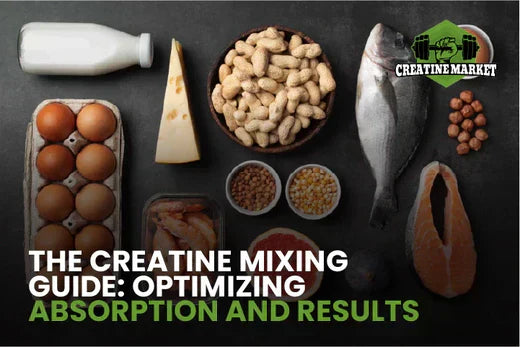The debate around creatine loading has persisted in fitness communities for years. While some advocate for this rapid saturation approach, others prefer a more gradual method. This comprehensive guide examines the science behind creatine loading, its benefits and drawbacks, and how to implement it effectively if you choose this route.
What is the Creatine Loading Phase?
Creatine loading represents a strategic approach to rapidly saturate your muscle cells with creatine. This protocol typically involves taking higher doses of creatine for a short period, followed by a lower maintenance dose. The primary goal is to achieve maximum creatine saturation in muscle tissue as quickly as possible, potentially accelerating the benefits of supplementation.
The Science Behind Loading
Understanding the biological mechanisms of creatine loading helps explain its potential benefits. Your muscles naturally store creatine, but most people's muscles are only 60-80% saturated without supplementation. Loading protocols aim to quickly reach 100% saturation by flooding the system with creatine, allowing your muscles to store more than they would through gradual supplementation.
Is Loading Creatine Necessary?
While loading can accelerate initial results, it isn't strictly necessary for achieving creatine's benefits. Research shows that taking a standard dose of 3-5 grams daily will eventually lead to the same saturation levels as loading - it just takes longer, typically 3-4 weeks instead of 5-7 days. This raises an important question: is the faster timeline worth the potential drawbacks?
Benefits of Loading Creatine
The advantages of creatine loading extend beyond simply achieving faster saturation. Understanding these benefits in detail can help you make an informed decision about whether loading is right for your goals.
Rapid Muscle Saturation of Creatine
Loading protocols significantly accelerate the process of reaching maximum creatine storage in muscle tissue. During loading, your muscles can achieve full saturation within 5-7 days, compared to the 3-4 weeks required with standard dosing. This rapid saturation occurs through several mechanisms:
First, the higher doses create a strong concentration gradient that enhances cellular uptake. Your muscle cells contain specialized creatine transport proteins that work more efficiently under these conditions. Additionally, the frequent dosing throughout the day maintains consistently elevated blood creatine levels, maximizing the opportunity for muscle uptake.
Research shows that successful loading can increase muscle creatine content by 20-40% within this short timeframe. This increased storage capacity directly translates to enhanced performance potential, particularly for high-intensity, short-duration activities.
Accelerated Performance Benefits
The faster saturation achieved through loading translates to quicker performance improvements across several metrics. Studies demonstrate that individuals following loading protocols often experience:
Peak power output increases within 5-7 days of beginning supplementation Significant improvements in repetition capacity during resistance training Enhanced recovery between sets of high-intensity exercise Increased work capacity during training sessions
These rapid improvements stem from the increased availability of phosphocreatine in muscle tissue, which provides immediate energy for explosive movements and helps maintain ATP levels during intense exercise.
Enhanced Training Adaptations
The accelerated saturation from loading may lead to superior training adaptations in the early weeks of a program. Research indicates that individuals who load creatine often experience:
More substantial strength gains in the first 1-2 weeks of training Greater increases in lean body mass during initial loading period Improved muscle fiber recruitment patterns Enhanced protein synthesis signaling
These early adaptations can establish a strong foundation for continued progress and may lead to superior long-term results compared to delayed saturation methods.
Psychological and Motivational Benefits
The rapid onset of results from loading can provide significant psychological advantages:
Immediate feedback through improved performance reinforces commitment to training Visible changes in muscle fullness and body composition boost motivation Early strength gains build confidence in both the supplement and training program Faster progress can help establish consistent supplementation habits
These psychological benefits often translate to improved adherence to both supplementation and training programs, potentially leading to better long-term results.
Competition Preparation
For athletes preparing for competition, loading offers several strategic advantages:
Allows for rapid optimization of creatine stores before important events Provides predictable timing for peak saturation levels Enables strategic planning around water retention and weight changes Maximizes performance potential within a short timeframe
This makes loading particularly valuable for athletes who need to peak for specific competitions or those who cycle their supplementation throughout the year.
Drawbacks of Loading Creatine
Consider these potential disadvantages before starting a loading protocol:
Digestive Discomfort
Higher doses during loading may cause gastrointestinal issues in some individuals. This typically includes bloating, cramping, or diarrhea, particularly when taking large amounts at once.
Water Retention
Rapid creatine loading often leads to increased water retention in muscle tissue. While this contributes to the desired cellular sizing effects, it can cause temporary weight gain and bloating.
How to Load Creatine Properly
If you decide to implement a loading protocol, follow these guidelines for optimal results:
Traditional Loading Protocol
The most researched loading protocol involves taking 20-25 grams of creatine daily for 5-7 days, divided into 4-5 equal servings. After this initial phase, transition to a maintenance dose of 3-5 grams daily.
Modified Loading Approach
For those concerned about digestive issues, consider a modified protocol of 15-20 grams daily for 7-10 days, split into 3-4 servings. This gentler approach may reduce side effects while still achieving relatively rapid saturation.
Optimizing Your Loading Phase
Several strategies can enhance the effectiveness of your loading protocol:
Timing Considerations
Space your doses throughout the day to maintain stable creatine levels. Taking doses with meals can improve absorption and minimize digestive issues.
Hydration
Hydration plays a crucial role during creatine loading. We need to drink enough water to help our bodies absorb creatine effectively. During the loading phase, we can take 20-30 grams of creatine daily for 5 to 7 days.
This increases the storage of creatine in our muscles, enhancing muscle energy levels and performance.
While taking high doses of creatine, we might notice an increase in water retention. Drinking plenty of fluids can prevent dehydration and support overall health. Mixing creatine with a carb- or protein-based meal may also aid absorption.
After the loading phase, maintaining hydration remains important as we shift to a lower dose of 3–5 grams per day to keep achieving those strength gains safely.
Maintenance After Loading
Once you complete the loading phase, proper maintenance ensures continued benefits:
Standard Maintenance
Take 3-5 grams of creatine daily to maintain muscle saturation levels. This amount compensates for natural creatine turnover and maintains optimal stores.
Activity-Based Adjustments
Consider increasing maintenance doses during periods of intense training or competition. Some athletes benefit from 5-10 grams daily during these high-demand phases.
Alternatives to Loading
For those who prefer to skip loading, alternative approaches can still deliver results:
Gradual Protocol
Taking 3-5 grams daily from the start will achieve full saturation within 3-4 weeks. This approach typically causes fewer side effects and may be more sustainable long-term.
Hybrid Approach
Some users implement mini-loading phases of 10 grams daily for 10-14 days, striking a balance between rapid saturation and side effect management.
Special Considerations
Different populations may need to adjust their approach to loading:
Athletes During Season
Consider timing loading phases during off-season or training blocks to avoid potential performance disruption from water retention or digestive issues.
Vegetarians and Vegans
Plant-based athletes might benefit more from loading due to naturally lower creatine stores. However, they should monitor response carefully and adjust dosing as needed.
Conclusion
Creatine loading offers a valid strategy for rapidly achieving muscle saturation and accelerating initial benefits. However, it isn't necessary for everyone. Consider your goals, timeline, and tolerance for potential side effects when deciding whether to load. If you choose to load, follow established protocols, stay well-hydrated, and transition properly to maintenance dosing. Remember that consistency with maintenance dosing ultimately matters more than initial loading strategies for long-term results.
The most important factor isn't whether you load creatine, but rather that you supplement consistently over time. Choose the approach that best fits your lifestyle and goals, and focus on maintaining regular supplementation for optimal results.




